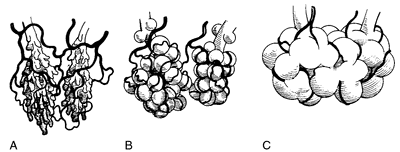Medical term:
pressure
pressure
(P) [presh´ur]
pres·sure (P, P),
(presh'ŭr),pressure
Vox populi A force or stress applied to a suface by a fluid or object, and measured in units of mass per unit area. See Blood pressure, Continuous positive airway pressure, Coronary perfusion pressure, End-diastolic pressure, End-systolic pressure, Intracranial pressure, Intraocular pressure, Intrauterine pressure, Negative pressure, Negative end-expiratory pressure, Oncotic pressure, Osmotic pressure, PEEP, Pulmonary-capillary pressure, Transpulmonary pressure, Wedge pressure.pres·sure
(presh'ŭr)pressure
blood pressure See sphygmomanometer.
equivalent oxygen pressure See equivalent oxygen pressure.
intraocular pressure (IOP) The pressure within the eyeball occurring as a result of the constant formation and drainage of the aqueous humour. This is measured by means of a manometer. What is actually measured in the human eye is the ocular tension by means of a tonometer. This is an indirect measure of the IOP as it depends on the thickness and rigidity of the tunics of the eye besides the IOP. Both terms, intraocular pressure and ocular pressure, are usually regarded as synonymous. Normal IOP is usually considered to be between 11 mmHg and 21 mmHg. However, there may be cases of glaucoma with lower IOP than 21 mmHg and there are also many normal cases with IOP greater than 21 mmHg. There is a slight increase in IOP with age (about 2 mmHg), in the morning as compared to the evening (about 3-4 mmHg), in the supine position as compared to the sitting position (about 3-4 mmHg), and a decrease during accommodation (about 4 mmHg). See in intraocular pressure diurnal variations; glaucoma; aqueous humour; ocular hypertension; ocular hypotony; scleral indentation; Imbert-Fick law; ocular rigidity; differential intraocular pressure test; provocative test; tonometer.
osmotic pressure The pressure required to stop the movement of water through a semipermeable membrane (e.g. corneal endothelium) from one solution of a given concentration to another of a different concentration. When the concentration of the solution on both sides of the membrane is equal, i.e. at equilibrium, the pressure of water on both sides of the membrane will be equal to the osmotic pressure and the movement of water will stop. The more concentrated the solution, the greater the osmotic pressure. See osmosis; hypertonic solution; hypotonic solution; isotonic solution.
pulse pressure See sphygmomanometer.
pres·sure
(P) (presh'ŭr)Patient discussion about pressure
Q. how can i reduce my blood pressure?
Q. what do i need to do to bring down my blood pressure? what cause a high blood pressure? what are the risks? of high blood pressure ? how can i deal with it effectively ?
http://www.ehow.com/how_12778_eat-lower-blood.html?ref=fuel&utm_source=yahoo&utm_medium=ssp&utm_campaign=yssp_art Hope this helps.
Q. What Are the Complications of High Blood Pressure? My wife suffers from high blood pressure. What are the possible complications that are so dangerous? Why is it important to keep high blood pressure under balance?
pressure
(P) [presh´ur]
pres·sure (P, P),
(presh'ŭr),pressure
Vox populi A force or stress applied to a suface by a fluid or object, and measured in units of mass per unit area. See Blood pressure, Continuous positive airway pressure, Coronary perfusion pressure, End-diastolic pressure, End-systolic pressure, Intracranial pressure, Intraocular pressure, Intrauterine pressure, Negative pressure, Negative end-expiratory pressure, Oncotic pressure, Osmotic pressure, PEEP, Pulmonary-capillary pressure, Transpulmonary pressure, Wedge pressure.pres·sure
(presh'ŭr)pressure
blood pressure See sphygmomanometer.
equivalent oxygen pressure See equivalent oxygen pressure.
intraocular pressure (IOP) The pressure within the eyeball occurring as a result of the constant formation and drainage of the aqueous humour. This is measured by means of a manometer. What is actually measured in the human eye is the ocular tension by means of a tonometer. This is an indirect measure of the IOP as it depends on the thickness and rigidity of the tunics of the eye besides the IOP. Both terms, intraocular pressure and ocular pressure, are usually regarded as synonymous. Normal IOP is usually considered to be between 11 mmHg and 21 mmHg. However, there may be cases of glaucoma with lower IOP than 21 mmHg and there are also many normal cases with IOP greater than 21 mmHg. There is a slight increase in IOP with age (about 2 mmHg), in the morning as compared to the evening (about 3-4 mmHg), in the supine position as compared to the sitting position (about 3-4 mmHg), and a decrease during accommodation (about 4 mmHg). See in intraocular pressure diurnal variations; glaucoma; aqueous humour; ocular hypertension; ocular hypotony; scleral indentation; Imbert-Fick law; ocular rigidity; differential intraocular pressure test; provocative test; tonometer.
osmotic pressure The pressure required to stop the movement of water through a semipermeable membrane (e.g. corneal endothelium) from one solution of a given concentration to another of a different concentration. When the concentration of the solution on both sides of the membrane is equal, i.e. at equilibrium, the pressure of water on both sides of the membrane will be equal to the osmotic pressure and the movement of water will stop. The more concentrated the solution, the greater the osmotic pressure. See osmosis; hypertonic solution; hypotonic solution; isotonic solution.
pulse pressure See sphygmomanometer.
pres·sure
(P) (presh'ŭr)Patient discussion about pressure
Q. how can i reduce my blood pressure?
Q. what do i need to do to bring down my blood pressure? what cause a high blood pressure? what are the risks? of high blood pressure ? how can i deal with it effectively ?
http://www.ehow.com/how_12778_eat-lower-blood.html?ref=fuel&utm_source=yahoo&utm_medium=ssp&utm_campaign=yssp_art Hope this helps.
Q. What Are the Complications of High Blood Pressure? My wife suffers from high blood pressure. What are the possible complications that are so dangerous? Why is it important to keep high blood pressure under balance?
Latest Searches:
ViaScint - viannia - Vianain - Vialetto - vial - Viadur - Viactiv - Viactin - viable - viability - VHDL - VHD - VFl - VFib - Vfend - VFC - Vexol - vexans - vexabilis - Vetuss -
- Service manuals - MBI Corp